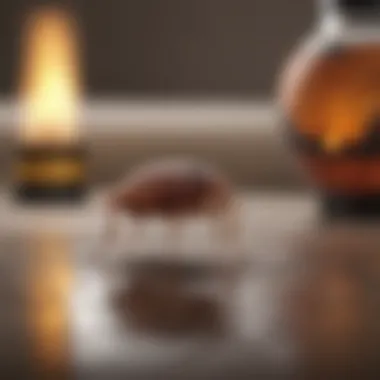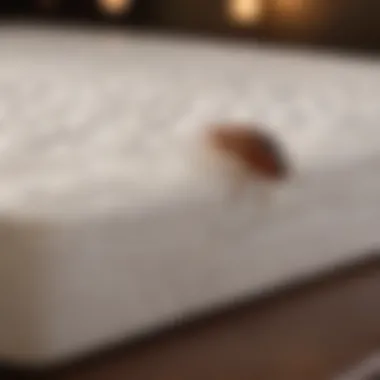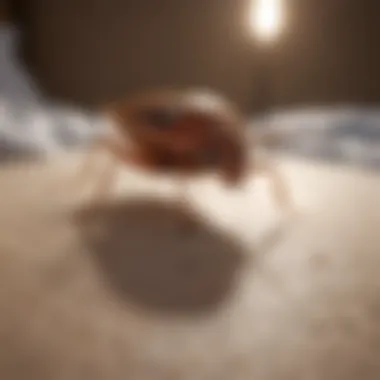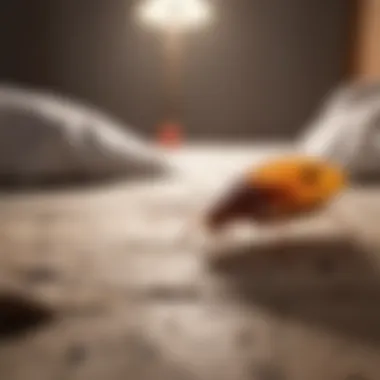Proven Remedies for Effective Bed Bug Removal


Animal Species Profile
In the realm of pest control, bed bugs reign as an insidious threat to one's peace and comfort. These minuscule, reddish-brown insects possess a knack for stealth and persistence, making them a formidable foe to encounter within one's abode. Characterized by their flat bodies and an unwelcomed propensity for human blood, bed bugs are unwavering in their quest for sustenance, often leaving a trail of itchy bites in their wake. Their adeptness at hiding in cracks, crevices, and even electrical outlets renders them challenging to eradicate.
With a natural habitat that pivots towards comfortable living spaces, bed bugs have adapted remarkably well to cohabiting with humans. While they do not thrive in outdoors environments, bed bugs have finely tuned their survival tactics to dwell in bedrooms, couches, and other common areas where humans dwell. Their proliferation can rapidly increase, gravely impacting the serenity of a home.
Popular Remedies for Bed Bug Infestation
When facing a bed bug infestation, individuals often seek to safeguard the sanctity of their living quarters promptly. Various remedies are prevalent in combating these pests, from natural alternatives to professional interventions. One approach involves the usage of diatomaceous earth, a fine powder derived from fossilized algae that desiccates bed bugs upon contact, effectively disrupting their protective exoskeleton. Heat treatments stand out as another formidable solution, as exposure to high temperatures can annihilate bed bugs at all life stages, including stubborn eggs.
Scent-based Deterrents and Repellents
Harnessing the power of scent, individuals can employ essential oils such as lavender, peppermint, or tea tree oil to deter bed bugs. These potent aromas act as a natural repellent, discouraging bed bugs from settling in bedding or furniture. Moreover, the application of double-sided tape or interceptors beneath bed legs can impede bed bugs' nocturnal movements, preventing them from ascending onto sleeping occupants.
Seeking Professional Assistance
In severe cases of infestation or persistent bed bug presence, enlisting the expertise of pest control professionals becomes an imperative step. These specialists employ a range of strategies, including targeted pesticide applications, steam treatments, or fumigation to address widespread infestations comprehensively. Additionally, their guidance can offer valuable insights on prevention strategies to mitigate future bed bug occurrences.
Synopsis
Banishing bed bugs from one's living environment demands a multi-faceted approach that combines proactive measures, diligent hygiene practices, and timely interventions. By arming oneself with knowledge on effective remedies and prevention strategies, individuals can safeguard their homes against these tenacious insects and restore tranquility to their living spaces.
Understanding Bed Bugs
In this segment, we delve into the critical topic of understanding bed bugs. Our journey begins with a detailed exploration of the various aspects surrounding the behavior, characteristics, and potential health risks associated with these notorious pests. By gaining a comprehensive understanding of bed bugs, readers can equip themselves with the knowledge necessary to tackle infestations effectively. Through a meticulous examination of this subject, we aim to provide valuable insights that can aid in the eradication and prevention of bed bug problems in living spaces.
Introduction to Bed Bugs
Bed bugs, the tiny nocturnal insects that feed on human blood, exhibit intriguing physical characteristics that make them formidable opponents in the battle against infestation. Despite their small size, these pests possess a remarkable ability to hide in crevices and furniture, making detection and elimination challenging for homeowners. Understanding the physical attributes of bed bugs is crucial for implementing targeted control measures and effectively eradicating these pests from households.
Physical Characteristics of Bed Bugs
One of the most distinctive features of bed bugs is their flat, oval-shaped bodies that range in color from reddish-brown to dark brown. These elusive insects lack wings but are adept at crawling and maneuvering through tight spaces, allowing them to remain concealed during daylight hours. Their minuscule size, typically around 5-7 millimeters in length, enables them to squeeze into tiny cracks and crevices, further complicating eradication efforts. While their appearance may seem innocuous, it is essential to recognize these physical traits to differentiate bed bugs from other common household pests.
Behavior and Habits of Bed Bugs
The nocturnal habits of bed bugs contribute significantly to their survival and proliferation within human habitats. These insects display a distinct preference for feeding on blood, primarily during the nighttime when hosts are most vulnerable. Their secretive behavior and aversion to light make them adept at evading detection, seeking refuge in bedding, mattresses, and nearby furniture. Understanding the behavioral patterns of bed bugs is paramount in developing strategies to disrupt their feeding cycles and reproductive capabilities, ultimately leading to successful elimination.
Health Risks Associated with Bed Bug Infestations
Apart from the annoyance and discomfort caused by bed bug bites, these pests also pose potential health risks to individuals living in infested environments. Allergic reactions, skin rashes, and secondary infections are common consequences of bed bug bites, particularly for sensitive individuals. Moreover, the psychological toll of dealing with persistent infestations cannot be overlooked, leading to stress, anxiety, and sleep disturbances. By recognizing the health hazards associated with bed bug infestations, individuals can prioritize proactive measures to safeguard their well-being and eliminate these pests from their surroundings.


Identifying Bed Bug Infestations
In this section, we unravel the mysteries surrounding bed bug infestations, equipping readers with the knowledge needed to detect and address these unwelcome intruders. By familiarizing themselves with the common signs of bed bugs, the optimal locations to inspect for infestations, and techniques for distinguishing bed bugs from other pests, individuals can take proactive steps to mitigate the risks posed by these cunning invaders. Through detailed guidance and insightful tips, we empower readers to become vigilant guardians of their living spaces, ensuring a pest-free environment for themselves and their loved ones.
Common Signs of Bed Bugs
Recognizing the telltale signs of bed bug activity is essential for early detection and intervention. These signs may include reddish-brown stains on bedding, evidence of shed skin or eggshells, and small red welts on the skin resulting from bed bug bites. By being alert to these indications, individuals can swiftly identify potential infestations and initiate appropriate countermeasures to prevent further spread. Understanding the significance of common signs associated with bed bugs is crucial for implementing timely interventions and safeguarding residential spaces from the detrimental effects of infestations.
Where to Look for Bed Bugs
When conducting inspections for bed bugs, it is imperative to focus on areas where these pests are most likely to congregate. Bed bugs have a proclivity for harboring in cracks and crevices near sleeping areas, such as mattress seams, headboards, and bedside furniture. Additionally, items with fabric or upholstery provide ideal hiding spots for bed bugs, requiring thorough scrutiny during inspection routines. By understanding the preferred harborage sites of bed bugs, individuals can streamline detection efforts and address infestations promptly, enhancing the efficacy of control measures.
Differentiating Bed Bugs from Other Pests
Distinguishing bed bugs from other household pests can be a challenging task, given their similarities in size and behavior. However, specific characteristics, such as the distinct reddish-brown coloration, flat bodies, and characteristic odor emitted by bed bugs, can aid in their identification. Contrasting these features with those of common pests like fleas or ticks enables individuals to accurately pinpoint the presence of bed bugs and tailor treatment strategies accordingly. By honing the skill of differentiating bed bugs from other intruders, homeowners can adopt targeted approaches to combat infestations and minimize the potential risks posed by these resilient insects.
Natural Remedies
Natural remedies play a crucial role in the fight against bed bugs, offering a safer and eco-friendly alternative to chemical treatments. The significance of natural remedies lies in their effectiveness in eradicating bed bugs while minimizing harm to the environment and human health. In this article, readers will delve into a variety of natural solutions that aim to combat bed bug infestations organically.
Essential Oils and DIY Sprays
When it comes to natural remedies for bed bug control, essential oils and DIY sprays have gained popularity for their effectiveness and non-toxic nature. Essential oils like Lavender oil serve as excellent bed bug repellents, acting as a natural deterrent against these pests. Tea Tree oil, known for its strong insecticidal properties, offers a powerful solution to combat bed bugs. Additionally, Peppermint oil works wonders in controlling bed bug populations, thanks to its potent aroma that repels these blood-sucking insects effectively.
Lavender Oil for Bed Bug Repellent
Lavender oil stands out as a top choice for bed bug repellent due to its soothing fragrance and insect-repelling properties. Its calming scent is a natural deterrent for bed bugs, making it a popular and effective choice for those seeking natural remedies. The unique feature of Lavender oil lies in its ability to not only repel bed bugs but also promote relaxation and stress relief for individuals struggling with infestations.
Tea Tree Oil as a Natural Insecticide
Tea Tree oil serves as a potent natural insecticide, capable of killing and repelling a variety of pests, including bed bugs. Its antifungal and antibacterial properties make it a beneficial choice for combating bed bug infestations naturally. One of the key characteristics of Tea Tree oil is its strong scent, which disorients bed bugs and disrupts their breeding cycles, aiding in effective population control.
Peppermint Oil for Bed Bug Control
Peppermint oil is renowned for its ability to deter pests, including bed bugs, due to its intense aroma that masks the scents they are attracted to. This natural remedy for bed bug control offers a minty fresh solution that effectively repels bed bugs and discourages infestations. The advantageous aspect of Peppermint oil lies in its non-toxic nature, making it a safe option for households looking to eliminate bed bugs without compromising on safety.
Diatomaceous Earth
Diatomaceous Earth, a natural sedimentary rock, serves as a powerful tool in the fight against bed bugs, thanks to its desiccating properties. This natural substance effectively dehydrates bed bugs upon contact, leading to their demise without the use of harsh chemicals. In this section, readers will explore how Diatomaceous Earth plays a pivotal role in eradicating bed bug infestations organically.
How Diatomaceous Earth Kills Bed Bugs


The mechanism through which Diatomaceous Earth kills bed bugs is by absorbing the protective waxy layer on their exoskeleton, causing them to desiccate and perish. This unique feature of Diatomaceous Earth makes it a popular choice for those looking for non-toxic methods to eliminate bed bugs effectively. Its abrasive nature ensures the demise of bed bugs while posing minimal risk to human health or the environment.
Application Methods for Diatomaceous Earth
When considering the application of Diatomaceous Earth, it is essential to dust it thinly and evenly in areas where bed bugs are prevalent. By strategically placing this natural powder near bed bug hideouts and potential entry points, it maximizes the chances of bed bugs coming into contact with it, leading to their eventual demise. Readers will gain insights into the practical application methods that ensure the successful use of Diatomaceous Earth for bed bug control.
Safety Precautions When Using Diatomaceous Earth
While Diatomaceous Earth is considered safe for use around humans and pets, it is crucial to take necessary safety precautions when handling it. This includes wearing protective gear such as masks and gloves during application to avoid inhalation or skin irritation. Additionally, care should be taken to keep Diatomaceous Earth dry, as moisture reduces its effectiveness in killing bed bugs. Readers will discover the importance of following safety guidelines to maximize the benefits of using Diatomaceous Earth as a natural remedy for bed bug control.
Home Remedies and Prevention
In this meticulously crafted guide on effective remedies to eradicate bed bugs, the section on Home Remedies and Prevention plays a pivotal role. Home remedies offer a natural and practical approach to tackling bed bug infestations. By leveraging everyday household items, individuals can minimize the presence of bed bugs and prevent future outbreaks. One key benefit of home remedies is their cost-effectiveness and the reduced reliance on potentially harmful chemicals. Additionally, by incorporating prevention strategies into their routine, individuals can create an inhospitable environment for bed bugs, thereby safeguarding their living spaces.
Washing and Heat Treatment
Hot Water Laundering of Infested Items
Hot water laundering of infested items is a crucial step in the battle against bed bugs. This process involves washing infested clothing, bedding, and other textiles at high temperatures to kill bed bugs and their eggs. The key characteristic of hot water laundering is its effectiveness in eliminating bed bugs at all life stages, from eggs to adults. This method is a popular choice for bed bug control due to its simplicity and accessibility. However, one disadvantage is that it may not reach hidden or hard-to-access areas, requiring additional treatment methods.
Heat Treatment for Bed Bug Control
Heat treatment is another potent weapon in the fight against bed bugs. By using heat to raise the temperature in infested areas above what bed bugs can tolerate, heat treatment effectively eradicates these pests. The key characteristic of heat treatment is its ability to penetrate cracks and crevices where bed bugs hide, ensuring comprehensive elimination. This method is a beneficial choice for its non-toxic nature, making it safe for both humans and pets. However, the main disadvantage of heat treatment is the potential for property damage if not conducted carefully.
Vacuuming and Steam Cleaning Techniques
Vacuuming and steam cleaning are indispensable techniques for managing bed bug infestations. Vacuuming helps remove bed bugs, eggs, and droppings from surfaces, diminishing the population within the home. It also aids in the physical removal of bed bugs, decreasing the likelihood of reinfestation. Steam cleaning, on the other hand, uses high temperatures to kill bed bugs and their eggs on household items such as mattresses, furniture, and carpets. This technique's key advantage is its eco-friendly nature, as it does not involve chemicals that may be harmful to the environment. However, consistent and thorough cleaning is essential for effective bed bug control.
Decluttering and Sealing Cracks
Importance of Decluttering for Bed Bug Prevention
Decluttering is a fundamental aspect of bed bug prevention. By reducing clutter in living spaces, individuals eliminate hiding spots for bed bugs, making detection and treatment easier. The key characteristic of decluttering is its ability to minimize the areas where bed bugs can thrive, thereby enhancing the effectiveness of other control methods. Decluttering is a popular choice for its proactive approach to preventing bed bug infestations and maintaining a tidy living environment. However, one disadvantage is that decluttering may be time-consuming, especially in cases of severe clutter.
Sealing Entry Points and Cracks in Furniture
Sealing entry points and cracks in furniture is a critical step in fortifying your home against bed bug invasions. By sealing off potential entryways, individuals can restrict bed bugs' access to their living spaces, reducing the risk of infestations. The key characteristic of sealing cracks is its ability to block bed bug movement and limit their spread within a household. This method is a beneficial choice for its long-term effectiveness in preventing bed bug incursions. However, one disadvantage is that thorough inspection and maintenance are necessary to ensure all cracks are properly sealed, requiring ongoing diligence.
Professional Treatments
In the realm of combating bed bug infestations, the utilization of professional treatments emerges as a pivotal strategy. Professional treatments offer a comprehensive and effective approach to eradicating these pesky parasites from living spaces. An essential element of this article, professional treatments provide a well-rounded solution that dives deep into exterminating bed bugs efficiently. By entrusting the task to experts in pest control, individuals can ensure a thorough and lasting removal of bed bugs, restoring peace of mind and comfort within their homes.


Pest Control Services
Benefits of Hiring Professional Exterminators
Delving into the noteworthy advantages of enlisting professional exterminators unveils a wealth of benefits for battling bed bug infestations. The core benefit lies in the expertise and experience these professionals bring to the table. Professional exterminators possess in-depth knowledge of bed bug behavior, enabling them to devise targeted and strategic treatment plans. Their adeptness in using specialized equipment and methods ensures a higher success rate in exterminating bed bugs effectively. Moreover, the use of professional services guarantees a systematic approach, addressing not only the existing infestation but also implementing preventive measures to deter future occurrences.
Types of Treatments Offered by Pest Control Companies
Exploring the diverse array of treatments offered by pest control companies sheds light on the versatility and efficacy of professional solutions. Pest control companies typically provide a range of treatment options tailored to varying degrees of infestation. These treatments may include chemical applications, heat treatments, or fumigation, each catering to specific scenarios. The advantage of accessing such a repertoire of treatments enables homeowners to choose methods that align best with their preferences and the severity of the infestation. Additionally, pest control companies ensure the use of industry-approved products and techniques, guaranteeing a safe and thorough eradication process.
Cost Considerations for Professional Bed Bug Removal
Considering the financial aspect of professional bed bug removal underscores the investment value of such services. While costs may vary depending on the extent of infestation and the chosen treatment method, the expenses incurred reflect the meticulous and specialized nature of professional bed bug removal. It is imperative to view these costs not merely as expenditures but as prudent investments in safeguarding one's living environment. The long-term benefits of professional bed bug removal far outweigh the initial financial outlay, offering a pest-free and comfortable living space in exchange.
Heat Treatments and Fumigation
Effectiveness of Heat Treatments
Engaging with the efficacy of heat treatments unveils a potent weapon in the battle against bed bugs. Heat treatments target bed bugs at all life stages, penetrating fabrics and furniture to eliminate hidden infestations. The key characteristic of heat treatments lies in their non-toxic and environmentally friendly nature, making them a preferred choice for households with individuals sensitive to chemical treatments. The unique feature of heat treatments is their ability to reach crevices and areas inaccessible with traditional methods, ensuring a thorough eradication process that leaves no room for bed bug resurgence.
Process of Fumigation for Severe Infestations
Navigating through the process of fumigation for severe infestations reveals a stringent yet highly effective approach to combatting bed bugs. The integral characteristic of fumigation lies in its comprehensive reach, penetrating deep into furnishings and structural elements to exterminate bed bugs at all stages of development. This method is particularly advantageous for severe infestations or cases where bed bugs have spread extensively. However, the unique feature of fumigation also presents considerations regarding vacating the premises during treatment and ensuring proper aeration post-fumigation to guarantee safe reoccupation and optimal results.
Additional Tips and Recommendations
In this section, additional tips and recommendations play a crucial role in enhancing the effectiveness of bed bug elimination strategies. These tips serve as supplementary measures to bolster the primary remedies discussed earlier in the article. By incorporating these additional tips, readers can ensure a more comprehensive approach towards eradicating bed bugs from their living spaces. Whether it's reinforcing preventive measures or fine-tuning treatment techniques, these recommendations aim to provide a well-rounded plan for tackling bed bug infestations effectively. Readers are encouraged to carefully implement these tips in conjunction with other remedies to optimize their efforts in combating these persistent pests.
Monitoring Bed Bug Activity
Using Bed Bug Traps
Using bed bug traps is a pivotal component of monitoring bed bug activity within a home environment. These traps are designed to attract and capture bed bugs, enabling homeowners to gauge the extent of infestation and track the effectiveness of their treatment methods. Bed bug traps are a valuable tool in early detection, allowing residents to intervene promptly before the infestation escalates. The key feature of bed bug traps lies in their non-toxic and discreet nature, making them a preferred choice for monitoring purposes without posing any risks to household members. However, it's essential to note that while bed bug traps aid in detection, they may not serve as standalone solutions and should be utilized in conjunction with other remedial measures for comprehensive control.
Regular Inspections for Early Detection
Regular inspections for early detection serve as a proactive approach to identifying bed bug infestations before they proliferate. By conducting routine checks in common hiding spots and areas prone to infestation, individuals can nip potential bed bug problems in the bud. The key characteristic of regular inspections lies in their preventative nature, emphasizing the importance of vigilance and thoroughness in monitoring for any signs of bed bug activity. This proactive measure allows for swift intervention and tailored treatment approaches, minimizing the impact of infestations on the household environment. While regular inspections require diligence and attention to detail, the benefits of early detection far outweigh the efforts invested, safeguarding against extensive infestations and property damage.
Consulting with Professionals
Seeking Advice from Entomologists or Pest Control Experts
Seeking advice from entomologists or pest control experts is a valuable resource for homeowners facing persistent bed bug challenges. These professionals possess specialized knowledge and expertise in dealing with pest infestations, offering tailored recommendations and treatment strategies based on the specific circumstances. The key characteristic of consulting with professionals lies in the personalized guidance and professional insights provided, steering individuals towards effective solutions aligned with the severity of their infestation. By leveraging the experience of entomologists and pest control experts, homeowners can gain clarity on the infestation extent, appropriate treatment options, and preventive measures for long-term control.
Considering Long-Term Prevention Strategies
Considering long-term prevention strategies is paramount in sustaining a bed bug-free environment beyond immediate treatment efforts. These strategies encompass proactive measures aimed at fortifying property defenses and minimizing the risk of future infestations. The key feature of long-term prevention lies in its focus on preventative actions, adopting practices that deter bed bugs and create inhospitable conditions for their survival. While initial treatment is crucial, incorporating long-term prevention strategies ensures sustained protection against recurrent infestations, fostering a secure and pest-free living environment. By embracing these preventative approaches, individuals can fortify their defenses and safeguard against potential bed bug resurgence over time.







